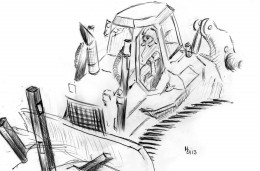
Dickinson Community, in many ways, represents the model for on-campus housing. Its six buildings were the first dorms at Binghamton and the community is cherished for its traditions and close-knit relationships. This fall semester Dickinson will abandon its original buildings and move across the street to four new, colossal mega-dorms. This move jeopardizes Dickinson’s spirit and marks some troubling trends in campus housing.
Dickinson Community, or “the Dick,” as it’s favorably known to residents, proudly bears its own virtues. Sure, Dickinson may not be the most comfortable or posh community on campus — it’s no Newing. But between the traditions and warm sense of community, students in Dickinson take the fact that they’ve been shafted by the housing gods and use it to gain an appreciation for each other and their, uh, unique facilities.
But the move across the street has serious costs.
In the new Dickinson halls, students are bunched into “flats” of either four single rooms, or two doubles and a single. These flats will have their own bathrooms and entryways, but we’re not talking about lounges where you can hang out, like in Mountainview or CIW. The entryways are just that. Narrow, tight vestibules with enough room for a sink and maybe an overpriced miniature cactus you picked up from that guy who sells obscure flowers outside the University Union once it gets a little nice out.
Dickinson’s current corridor-style rooms facilitate the close-knit relationships and community spirit for which Dickinson is cherished. Are private bathrooms worth sacrificing Dickinson’s sense of togetherness? More broadly, this move reflects campus housing’s wider trend of moving away from smaller and more intimate communities to larger, more impersonal accommodations.
Just look at the new buildings from the outside. The new Dickinson mega-structures are imposing and unwelcoming; they completely belie Dickinson’s spirit.
Internally, from what we’ve seen of the floor plans, it’s difficult to consider an architectural layout less conducive to Dickinson’s open and social spirit. The new halls are cloistered, designed more appropriately for reclusive monks than social students.
The administration did the Dickinson community a disservice in organizing the dorms this way. Why put up more doors between the friendliest students on campus? They can transplant the gazebo and even uproot the Object, but Dickinson’s spirit will be fundamentally changed.
It’s up to the community’s new residents to carry over the old traditions, and to create their own in New Dick. Come September, we hope to see a stimulated, social body of students engaging with one another. And even with the changes in place, we’re not too worried; students from Dickinson know how to make the best of a tight situation.
That’s why when things get hard, the Dick will stand proud.


